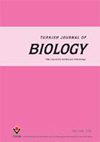Effect of mutation in active site residue Trp209 to Val, Leu, Ile and Pro on the catalytic activity and affinity for some benzenesulfonamides of human carbonic anhydrase II
IF 0.9
4区 生物学
Q3 BIOLOGY
引用次数: 1
Abstract
Human carbonic anhydrase II (hCA II) enzyme was firstly expressed using a pET-SUMO expression vector in Escherichia coli and the recombinant enzyme was purified using nickel (Ni2+) affinity chromatography. The substitutions of Trp 209 with four amino acid (Val, Leu, Ile, and Pro) in the hydrophobic pocket of hCA II were conducted using site-directed mutagenesis. The p-nitrophenyl esterase activity of hCA II variants correlates with the hydrophobicity and size of residue, suggesting that the hydrophobic character of this residue is important for catalysis. The Trp 209 was forecast as an important residue and was exposed to computational mutagenesis. This forecast was confirmed experimentally by producing hCA II mutants and determining the resulting affinities towards some benzenesulfonamides. These mutations in the hydrophobic pocket of the enzyme active site decreased the protein expression of hCA II in E. coli, causing the formation of insoluble protein aggregates in many cases. Our findings demonstrated that the Trp 209 in hCA II plays an important role in the folding process and the valine residues are very compatible for the hydrophobic region in the active cavity of this isoenzyme. These mutant proteins will lead to a better understanding of structural functions and drug-based studies in the future.活性位点Trp209突变为Val、Leu、Ile和Pro对人碳酸酐酶II对某些苯磺酰胺的催化活性和亲和力的影响
首先用pET-SUMO表达载体在大肠杆菌中表达人碳酸酐酶II(hCAII),并用镍(Ni2+)亲和层析纯化重组酶。在hCA II的疏水口袋中用四个氨基酸(Val、Leu、Ile和Pro)取代Trp 209是使用定点突变进行的。hCA II变体的对硝基苯基酯酶活性与残基的疏水性和大小相关,表明该残基的亲水性对催化作用很重要。Trp 209被预测为一个重要的残基,并暴露于计算诱变。通过产生hCA II突变体并测定由此产生的对一些苯磺酰胺的亲和力,实验证实了这一预测。酶活性位点疏水口袋中的这些突变降低了大肠杆菌中hCA II的蛋白质表达,在许多情况下导致不溶性蛋白质聚集体的形成。我们的研究结果表明,hCA II中的Trp 209在折叠过程中起着重要作用,缬氨酸残基与该同工酶活性腔中的疏水区非常相容。这些突变蛋白将在未来更好地理解结构功能和基于药物的研究。
本文章由计算机程序翻译,如有差异,请以英文原文为准。
求助全文
约1分钟内获得全文
求助全文
来源期刊

Turkish Journal of Biology
BIOLOGY-
CiteScore
4.60
自引率
0.00%
发文量
20
审稿时长
6-12 weeks
期刊介绍:
The Turkish Journal of Biology is published electronically 6 times a year by the Scientific and Technological
Research Council of Turkey (TÜBİTAK) and accepts English-language manuscripts concerning all kinds of biological
processes including biochemistry and biosynthesis, physiology and metabolism, molecular genetics, molecular biology,
genomics, proteomics, molecular farming, biotechnology/genetic transformation, nanobiotechnology, bioinformatics
and systems biology, cell and developmental biology, stem cell biology, and reproductive biology. Contribution is open
to researchers of all nationalities.
 求助内容:
求助内容: 应助结果提醒方式:
应助结果提醒方式:


